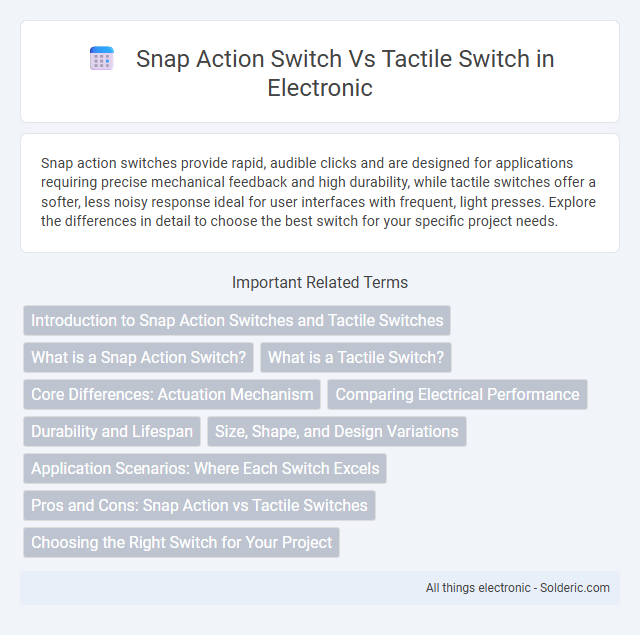Snap action switches provide rapid, audible clicks and are designed for applications requiring precise mechanical feedback and high durability, while tactile switches offer a softer, less noisy response ideal for user interfaces with frequent, light presses. Explore the differences in detail to choose the best switch for your specific project needs.
Comparison Table
| Feature | Snap Action Switch | Tactile Switch |
|---|---|---|
| Operation Mechanism | Rapid on-off mechanical action with a snap | Small bump feedback without strong snapping |
| Size | Larger, bulky design | Compact, miniature size |
| Durability (Lifespan) | High, typically 1 million+ cycles | Moderate, usually 100,000 to 1 million cycles |
| Contact Rating | Higher current and voltage capabilities | Lower current and voltage ratings |
| Application | Industrial controls, limit switches, appliances | Consumer electronics, keyboards, small devices |
| Feedback | Distinct audible and tactile snap | Soft tactile bump, less audible |
| Cost | Generally higher due to robustness | Lower cost, mass-produced |
Introduction to Snap Action Switches and Tactile Switches
Snap action switches provide rapid, precise on-off switching through a mechanical snap mechanism, ideal for applications requiring reliable, high-speed actuation. Tactile switches offer a distinct tactile feedback with a softer touch, making them suitable for user interfaces where a noticeable press response enhances usability. Your choice between these switches depends on the need for speed and reliability versus the desire for user-friendly, tactile feedback.
What is a Snap Action Switch?
A snap action switch is an electromechanical device designed to rapidly change its contact state with minimal actuator movement, providing a distinct tactile click or snap when activated. It operates using a spring mechanism that causes an abrupt transition between open and closed positions, ensuring reliable and consistent switching performance. Commonly used in limit switches, safety devices, and control panels, snap action switches are valued for their durability and precise response.
What is a Tactile Switch?
A tactile switch is a type of momentary switch that provides a noticeable physical feedback or "click" when pressed, enhancing user interface response without the need for a continuous hold. It operates through a small metal dome that collapses under pressure, closing the circuit and returning to its original state once released. Commonly used in keyboards, consumer electronics, and control panels, tactile switches offer precise actuation force and reliable switching performance.
Core Differences: Actuation Mechanism
Snap action switches use a spring-loaded mechanism that rapidly changes state with a distinct click, providing reliable and tactile feedback for precise control. Tactile switches rely on a small, flexible dome that collapses under pressure, offering a softer, less pronounced clicking sensation. The core difference lies in snap action switches delivering a quick electrical transition with high durability, while tactile switches prioritize subtle feedback in compact electronic devices.
Comparing Electrical Performance
Snap action switches provide higher current and voltage ratings, often handling up to 15A at 250V AC, making them suitable for heavy-duty applications. Tactile switches typically operate at lower currents, around 50mA at 12V DC, ideal for low-power electronic devices requiring precise, momentary contact. Understanding these electrical performance differences ensures Your choice aligns with the current load and durability requirements of Your specific application.
Durability and Lifespan
Snap action switches offer superior durability with mechanical designs capable of millions of cycles, making them ideal for heavy-duty applications requiring long lifespan. Tactile switches, while providing reliable feedback and suitable for low to medium usage, generally have a shorter operational life, typically rated between 100,000 to 1 million actuations. The robust construction and rapid contact separation of snap action switches contribute significantly to their enhanced longevity compared to the more compact and delicate tactile switches.
Size, Shape, and Design Variations
Snap action switches typically feature a robust, larger design with a lever or button mechanism suited for high-actuation force, making them ideal for industrial applications requiring durability. Tactile switches are generally smaller, with a compact, low-profile shape designed for quick, light presses, commonly found in consumer electronics and keyboards. Your choice hinges on the spatial constraints and actuation feel necessary for your specific device, balancing size, shape, and design variations accordingly.
Application Scenarios: Where Each Switch Excels
Snap action switches excel in industrial machinery and automotive controls due to their durability and ability to handle high current loads, making them ideal for safety and limit switch applications. Tactile switches are perfect for consumer electronics, such as keyboards and remote controls, offering a compact design and responsive feedback for frequent user interactions. Your choice depends on whether you need robust performance for heavy-duty tasks or precise, low-force actuation in compact devices.
Pros and Cons: Snap Action vs Tactile Switches
Snap action switches offer rapid on-off operation with high durability, making them ideal for applications requiring precise mechanical feedback, but they tend to be bulkier and noisier. Tactile switches provide a softer, quieter response with a compact design suitable for user interfaces, though they may have a shorter lifespan and less definitive actuation feel. Your choice between snap action and tactile switches should balance the need for durability and feedback against space constraints and user experience.
Choosing the Right Switch for Your Project
Snap action switches offer fast, reliable mechanical movement with a distinct click, making them ideal for applications requiring precise on/off signals and high durability, such as industrial controls. Tactile switches provide a softer, quieter feedback and are better suited for low-force, compact electronic devices like remote controls and handheld gadgets. Selecting the right switch depends on factors like actuation force, travel distance, environmental conditions, and device size, ensuring optimal performance and user experience.
snap action switch vs tactile switch Infographic

 solderic.com
solderic.com